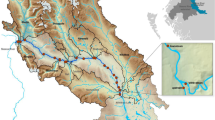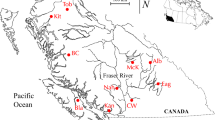Abstract
The Chinook salmon (Oncorhynchus tshawytscha) spawns and rears in the cold, freshwater rivers and tributaries of California’s Central Valley, with four separate seasonal runs including fall and late-fall runs, a winter run, and a spring run. Dams and reservoirs have blocked access to most of the Chinook’s ancestral spawning areas in the upper reaches and tributaries. Consequently, the fish rely on the mainstem of the Sacramento River for spawning habitat. Future climatic warming could lead to alterations of the river’s temperature regime, which could further reduce the already fragmented Chinook habitat. Specifically, increased water temperatures could result in spawning and rearing temperature exceedences, thereby jeopardizing productivity, particularly in drought years. Paradoxically, water management plays a key role in potential adaptation options by maintaining spawning and rearing habitat now and in the future, as reservoirs such as Shasta provide a cold water supply that will be increasingly needed to counter the effects of climate change. Results suggest that the available cold pool behind Shasta could be maintained throughout the summer assuming median projections of mid-21st century warming of 2°C, but the maintenance of the cold pool with warming on the order of 4°C could be very challenging. The winter and spring runs are shown to be most at risk because of the timing of their reproduction.
Similar content being viewed by others
References
Berman CH (1990) The effect of elevated holding temperatures on adult spring Chinook salmon reproductive success. M.S. Thesis, University of Washington, Seattle, WA
Bisson PA, Davis GE (1976) Production of juvenile Chinook salmon, Oncorhynchus tshawytyscha, in a heated model stream. NOAA Fish Bull 74(4):763–774
California Department of Water Resources (DWR) (1988) Water temperature effects on Chinook salmon (Oncorhynchus tshawytscha) with emphasis on the Sacramento River. A Literature Review. DWR Northern District, January, 1988
CALSIM II, (2000) Water Resource Simulation Model Manual, California Department of Water Resources, 1416 9th Street, Sacramento, CA 95814
Doherty J (2002) Model Independent Parameter Estimation, (PEST), User’s Manual, 5th Addition, Watermark Numerical Computing, 7944 Wisconsin Ave, Bethesda MD. 20814
Field CB, Daily GC, Davis FW, Gaines S, Matson PA, Melack J, Miller NL (1999) Confronting climate change in California. The Union of Concerned Scientists and The Ecological Society of America, November
Hallock RJ, Elwell RF, Fry DH (1970) Migrations of adult king salmon Oncorhynchus tshawytscha in the San Joaquin Delta as demonstrated by the use of sonic tags. California Department of Fish and Game, Sacramento, CA
Hayhoe K, et al. (2004) Emissions pathways, climate change and impacts on California, 2004. The Proceedings of the National Academy of Sciences, 101, 34
Hinze JA, Culver AN, Rice GV (1956) Annual Report: Nimbus salmon and steelhead hatchery, fiscal year 1955–56, California Department of Fish and Game, Inland Fish. Admin. Rep. No. 56–25, Sacramento, CA
Hsu NS, Cheng KW (2002) Network flow optimization model for Basin-Scale water supply planning. J Water Resour Plan Manage 128(2):102–112
Leitritz E, Lewis RC (1976) Trout and salmon culture. California Department of Fish and Game, Fish Bull, Sacramento, CA
Marine KR, Cech JJ (1998) Effects of elevated water temperature on some aspects of the physiological and ecological performance of juvenile Chinook salmon, Oncorhynchus tshawytscha: implications for management of California’s Chinook salmon stocks. Stream Temperature Monitoring and Assessment Workshop, January, 1998. Sacramento, California, Forest Science Project. Humboldt State University, Arcata, California
Maurer EP (2007) Uncertainty in hydrologic impacts of climate change in the Sierra Nevada, California under two emissions scenarios. Clim Change 82(3–4):309–325
Maurer EP, Wood AW, Adam JC, Lettenmaier DP, Nijssen B (2002) A long-term hydrologically-based data set of land surface fluxes and states for the conterminous United States. J Climate 15(22):3237–3251
McCullough DA (1999) A review and synthesis of effects of alterations to the water temperature regime on freshwater life stages of salmonids with special reference to Chinook Salmon. U.S. EPA, Region 10, Seattle, WA
Meehan WR, Bjornn TC (1991) Salmonid distributions and life histories. In: Meehan WR (ed) Influences of forest and rangeland management on salmonid fishes and their habitat. American Fisheries Society Special Publication 19, Bethesda, MD
Moyle PB, Van Dyck PC, Tomelleri J (2002) Inland fishes of California. University of California Press, Berkeley, California
NOAA (2001) Status review of Chinook Salmon from Washington, Idaho, Oregon, and California. NOAA Technical Memorandum NMFS-NWFSC-35
San Francisco Estuary Project (SFEP) (1992) State of the estuary. A report on conditions and problems in the San Francisco Bay/Sacramento-San Joaquin Delta Estuary. SFEP, Oakland, CA
Tebaldi C, Smith R, Nychka D, Mearns L (2005) Quantifying uncertainty in projections of regional climate change: a Bayesian approach to the analysis of multi-model ensembles. J Clim 18(10):1524–1540
United States Department of Interior (USDOI) (1996) Recovery plan for the Sacramento/San Joaquin Delta native fishes. U.S. Fish and Wildlife Service, Sacramento, California
Vogelmann JE, Howard SM, Yang L, Larson CR, Wylie BK, Van Driel N (2001) Completion of the 1990s total impervious area for the conterminous United States from landsat thematic mapper data and ancillary data sources. Photogramm Eng Remote Sensing 67:650–652
Westphal K, Vogel R, Kirshen P, Chapra S (2003) Decision support system for adaptive water supply management. J Water Resour Plan Manage 129(3):165–177
Yates D, Sieber J, Purkey D, Huber-Lee A (2005a) WEAP21 a demand, priority, and preference driven water planning model: part 1, model characteristics. Water Int 30(4):487–500
Yates D, Purkey D, Galbraith H, Huber-Lee A, Sieber J (2005b) WEAP21 a demand, priority, and preference driven water planning model: part 2, aiding freshwater ecosystem service evaluation. Water Int 30(4):501–512
Author information
Authors and Affiliations
Corresponding author
Rights and permissions
About this article
Cite this article
Yates, D., Galbraith, H., Purkey, D. et al. Climate warming, water storage, and Chinook salmon in California’s Sacramento Valley. Climatic Change 91, 335–350 (2008). https://doi.org/10.1007/s10584-008-9427-8
Received:
Accepted:
Published:
Issue Date:
DOI: https://doi.org/10.1007/s10584-008-9427-8




